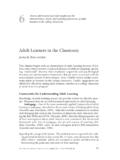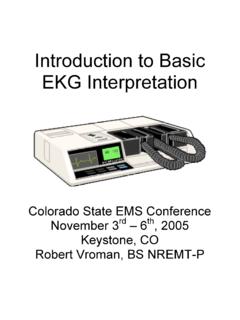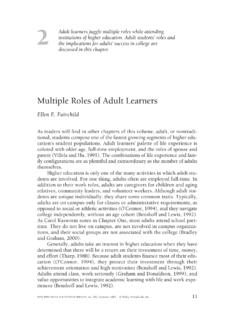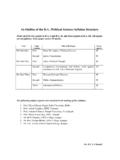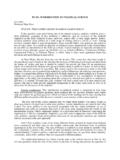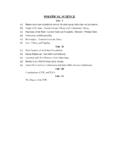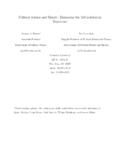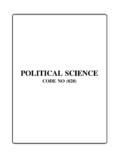Transcription of Active Learning Techniques Versus Traditional …
1 Innovative Higher Education, Vol. 24, No. 4, Summer 2000. Active Learning Techniques Versus Traditional teaching Styles: Two Experiments from History and political Science J. Patrick McCarthy and Liam Anderson ABSTRACT: Group role-playing and collaborative exercises are exciting ways to diversify college students' classroom experience and to incorporate Active Learning into your teach- ing. This article reports the results of two experiments that compared the effectiveness of role-playing and collaborative activities to teacher-centered discussions and lectures. Using both history and political science classes, we show that the students who partic- ipated in the role-plays and collaborative exercises did better on subsequent standard evaluations than their traditionally instructed peers.
2 Presented here is a discussion of Active Learning , descriptions of the two experiments, and an explanation of the outcomes and implications of the study. At many large colleges and universities like ours, the lecture still seems to be the centerpiece of instruction, where students passively absorb pre-processed information and then regurgitate it in response to periodic multiple-choice exams. While graders and teaching assis- tants make essay examinations and discussion sections possible, rarely do they effect significant change in the passive nature of the Learning experience for these (mostly introductory or survey) classes. Such an environment provides incentives to learn only at the surface (passive). level rather than at the deep ( Active ) level (Marton & Saljo, 1976).
3 Ac- cording to Jaques (1992), the Traditional format encourages students to concentrate on superficial indicators rather than on fundamental underlying principles, thus neglecting deep ( Active ) Learning . Active Learning refers to "experiences in which students are thinking about the subject matter" as they interact with the instructor and each other (McKeachie, 1999, p. 44; Gamson, 1991). This type of Learning is impor- tant to all disciplines and fields, but it is critical to the humanities and J. Patrick McCarthy received the from the University of Virginia and the from the University of Georgia, where he is currently a candidate and teaches and World history courses. He is researching the controversies surrounding college and university curricular reform in the nineteenth century South.
4 Liam Anderson obtained the at Nottingham University, the in Philosophy from Cambridge University, and the from the University of Georgia. He is an Assistant Professor at Wright State University. 279 2000 Human sciences Press, Inc. 280 INNOVATIVE HIGHER EDUCATION. the social sciences . Human interaction lies at the heart of the disci- plines in these areas, yet instructors too often expect students to ac- quire relevant knowledge in a Learning environment with little inter- Active content. While logistic necessity (large class sizes) dictates that the lecture format will likely continue to be important in the Learning process, this only increases the need for balancing passive with Active Learning wherever and whenever the possibility arises. This article empirically examines the effectiveness of Active learn- ing strategies that are applicable to most social science and humanities courses and to other areas of study as well.
5 Specifically, we describe two activities one a group role-play in a history class, the other a collab- orative exercise in a political science class. The role-play required stu- dents to grasp the notion of multiculturalism in America during early colonization as they identified with one national or ethnic group. The collaborative exercise required students to analyze critically the word- ing of opinion poll questions as a source of potential distortion in opinion poll surveys. Both exercises emphasized the Active participation of the students in the Learning process. Both, therefore, are alternatives to the standard passive lecture and the teacher-centered discussion period. Af- ter describing the activities, we present the results of controlled experi- ments that tested their effectiveness as Learning tools relative to the tra- ditional formats.
6 We then conclude with an analysis of the implications of our results and suggestions for possible directions in future research. Benefits and Costs of Active Learning For the purposes of this article, Active Learning strategies refer to a va- riety of collaborative classroom activities, ranging from long-term sim- ulations to five-minute cooperative problem solving exercises (Bonwell & Eison, 1991; Sutherland & Bonwell, 1996). Rather than facilitat- ing the memorization of large quantities of information, activities like these stimulate inquiry and interest as students acquire knowledge and skills (Sheckley, 1989, p. 278, cited in Montgomery, Brown, & Deery, 1997, p. 219). Active Learning Techniques yield many benefits they are student-centered; they maximize participation; they are highly motiva- tional; and they give life and immediacy to the subject matter by en- couraging students to move beyond a superficial, fact-based approach to the material (Bonwell & Eison, 1991; Ladousse, 1987; McKeachie, 1999; Schaftel & Schaftel, 1976; Van Ments, 1994).
7 Several recent studies support these propositions (Elliot, 1993;. Somers & Holt, 1993). Miller and Grocchia (1997) made a direct Active Learning Techniques 281. controlled comparison between the standard lecture format and the co- operative Learning format in an introductory college-level biology course. They reported that students taking the cooperative format op- tion indicated significantly higher levels of satisfaction with the course than those taking the Traditional format option. In a similar vein, DeNeve and Heppner (1997) examined role-play simulations in an in- dustrial psychology course. Student responses were highly positive both immediately following the simulation and in follow-up interviews con- ducted eight months later. Montgomery, Brown, and Deery (1997) re- ported similar results.
8 Applying Kolb's (1984) "experiential Learning model" to a school board simulation used during an introductory edu- cation course at a small liberal arts college, they concluded that, "The simulation not only energized the students but also personalized an in-depth understanding of educational issues" (p. 217). These studies indicate that Active Learning strategies and Techniques help create a more stimulating and enjoyable classroom environment for students. Very little research, however, examines the actual effectiveness of Active Learning relative to Traditional teaching formats. DeNeve and Heppner (1997) reported that a search of the Educational Resources In- formation Center (ERIC) covering a three-year period unearthed 175 articles about Active Learning , but among these studies only twelve involved a direct comparison between Active Learning and other teach- ing methods.
9 A number of these twelve studies reported no significant differences between Active and passive teaching Techniques in terms of student performance (p. 232). Based on their own study, DeNeve and Heppner concluded, "These results agree with recent research that suggested that Active Learning Techniques are more effective for achiev- ing some goals, while lectures are more effective for achieving other goals" (p. 243). In their structured comparison of cooperative Versus Traditional formats, Miller and Groccia (1997) obtained similarly am- biguous results. In a post-course evaluation to test five dimensions of critical thinking skills, the students participating in the cooperative class performed no better than those participating in the Traditional class.
10 These results highlight the need for further research, particularly into whether there are costs as well as benefits to using Active learn- ing Techniques in the classroom. Regardless of the evident benefits of activities, they may not be the most efficient technique for imparting in- formation or for enhancing retention. Perhaps Traditional methods like lectures might meet these goals more effectively. This issue is especially pertinent in the context of introductory courses in the humanities and social sciences , where instructors must cover large quantities of basic 282 INNOVATIVE HIGHER EDUCATION. information in a limited period of time, yet have an obligation to nur- ture students' intellectual skills. Assuming that an important goal of such courses is for students to leave the class with a firm grasp of the subject-matter, it seems valid to question whether the time devoted to Active Learning exercises might not be better employed elsewhere.
